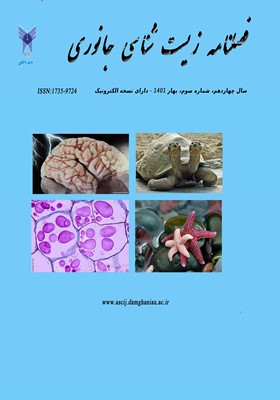تاثیر مکمل یاری کلم بروکلی همراه با تمرینات ترکیبی بر فاکتور رشد فیبروبلاستی-21 و مقاومت به انسولین در مردان چاق مبتلا به دیابت نوع دو
محورهای موضوعی : فصلنامه زیست شناسی جانوری
ابراهیم فلاح
1
,
ساناز میرزایان شانجانی
2
*
![]() ,
عبدالعلی بنایی فر
3
,
یاسر کاظم زاده
4
,
سعید صداقتی
5
,
عبدالعلی بنایی فر
3
,
یاسر کاظم زاده
4
,
سعید صداقتی
5
1 - گروه تربیت بدنی و علوم ورزشی، واحد اسلامشهر، دانشگاه آزاد اسلامی، اسلامشهر، ایران
2 - گروه تربیت بدنی و علوم ورزشی، واحد اسلامشهر، دانشگاه آزاد اسلامی، اسلامشهر، ایران
3 - گروه تربیت بدنی و علوم ورزشی، واحد تهران جنوب، دانشگاه آزاد اسلامی، تهران، ایران
4 - گروه تربیت بدنی و علوم ورزشی، واحد اسلامشهر، دانشگاه آزاد اسلامی، اسلامشهر، ایران
5 - گروه تربیت بدنی و علوم ورزشی، واحد اسلامشهر، دانشگاه آزاد اسلامی، اسلامشهر، ایران
کلید واژه: تمرین ترکیبی, کلم بروکلی, مقاومت به انسولین, مردان چاق, دیابت نوع دو, فاکتور رشد فیبروبلاستی-21,
چکیده مقاله :
دیابت یکی از عوامل اصلی مرگ و میر در کشورهای در حال توسعه است که عوامل مختلفی همچون فعالیت بدنی و رژیم غذایی مناسب می تواند باعث بهبود آن شود. هدف از پژوهش حاضر تعیین تاثیر مصرف پودر کلم بروکلی به همراه تمرین استقامتی-مقاومتی بر فاکتور رشد فیبروبلاستی-21 (FGF-21) و مقاومت به انسولین در مردان چاق مبتلا به دیابت نوع دو می باشد. 44 مرد دیابتی داوطلب بر اساس معیارهای ورود به تحقیق به صورت تصادفی در چهار گروه 11 نفری شامل گروه تمرین-مکمل، گروه تمرین-دارونما (تمرین)، گروه مکمل ، گروه دارو نما که تمام گروه ها دیابتی بودند، تقسیم شدند. پروتکل تمرین شامل 30 دقیقه تمرین هوازی (دویدن) با شدت 70-60 درصد ضربان قلب بیشینه و 45 دقیقه تمرین مقاومتی با شدت 70-60 درصد یک تکرار بیشینه بود. مکمل کلم بروکلی نیز به صورت پودر اماده تهیه و به هر داوطلب 10 گرم در روز به مدت 12 هفته داده شد. نمونه های خونی 48 ساعت قبل از شروع تمرینات و 48 ساعت بعد از آخرین جلسه تمرین گرفته شد . بررسی شاخص های بین گروهی نشان داد که در شاخصهای FGF-21 (017/0p =) و مقاومت به انسولین (01/0p =)، بین گروه های مختلف اختلاف معنی دار وجود دارد. در بررسی تغییرات درون گروهی نیز تغییرات معنی داری در شاخصها اندازه گیری شده در گروه های مختلف مشاهده شد (05/0p <). نتایج پژوهش حاضر نشان داد که 12 هفته مکمل یاری کلم بروکلی همراه با تمرینات ترکیبی سبب کاهش معنی دار FGF-21، گلوکز خون و مقاومت انسولینی در هر سه گروه مکمل، تمرین و تمرین-مکمل شده است. بنابراین به نظر می رسد مصرف کلم بروکلی در رژیم غذایی و تمرین به تنهایی و همچنین ترکیب این دو می تواند در تعدیل بیماری دیابت نوع دو نقش داشته باشد.
Diabetes is one of the leading causes of mortality in developing countries that can be improved by various factors such as physical activity and proper diet. The present study was aimed at examining the effect of broccoli powder supplementation with combined exercise training on FGF-21 and insulin resistance in type 2 diabetes men. This experimental design was conducted with pre-test and post-test and four groups. To this end, 44 volunteer diabetic men after homogenization based on individual characteristics were randomly assigned to four groups of 11 individuals including exercise-supplement group, exercise-placebo group (exercise), control-supplement group (supplement), and control-placebo (controls). Combined exercise program included 12 weeks, three sessions per week. Moreover, broccoli supplement was 10 grams per day for 12 weeks. The blood sample was taken 48 hours before and 48 hours after the last training session and used for analysis. Analysis of intergroup indicators revealed a significant difference between the groups in FGF-21 (p = 0.017) and insulin resistance (p = 0.01). Significant changes in the measured indices were also observed in the intragroup changes (p < 0.05). The results of this study showed that 12 weeks of combined exercise with broccoli supplement significantly reduced FGF-21, blood glucose, and insulin resistance in all three groups of exercise- supplement, exercise, and supplement. Therefore, incorporating broccoli into the diet can partially prevent the risky effects of type 2 diabetes.
_||_

